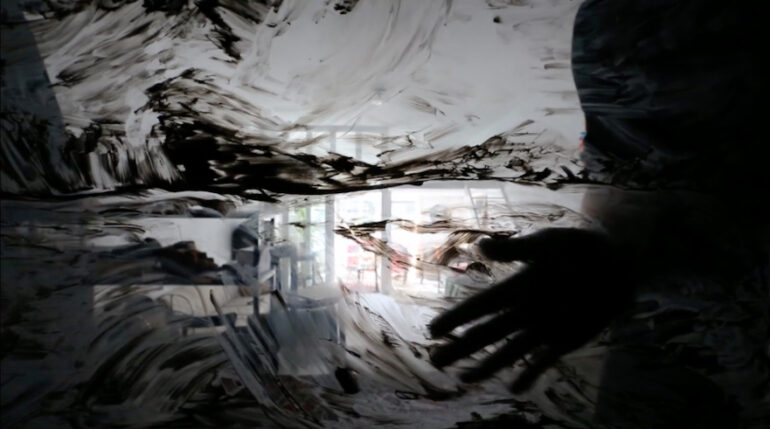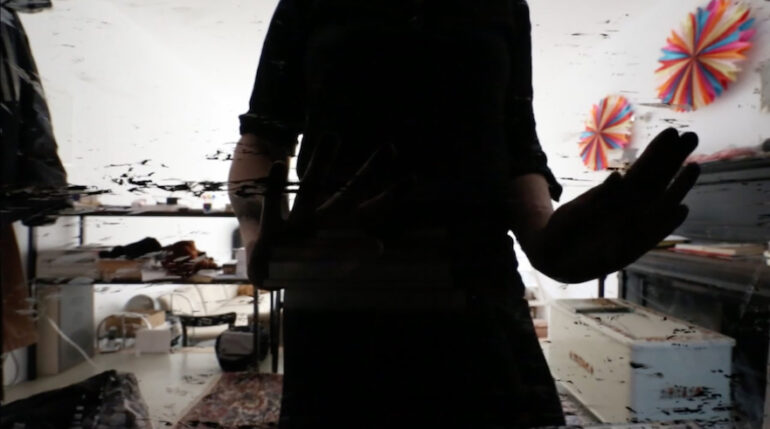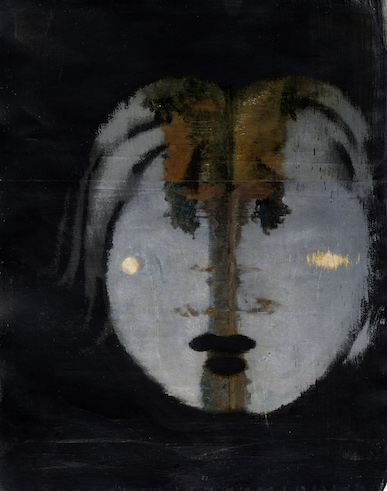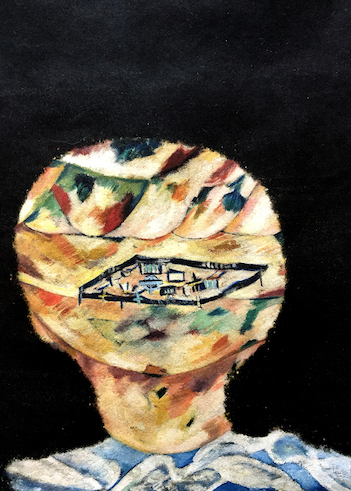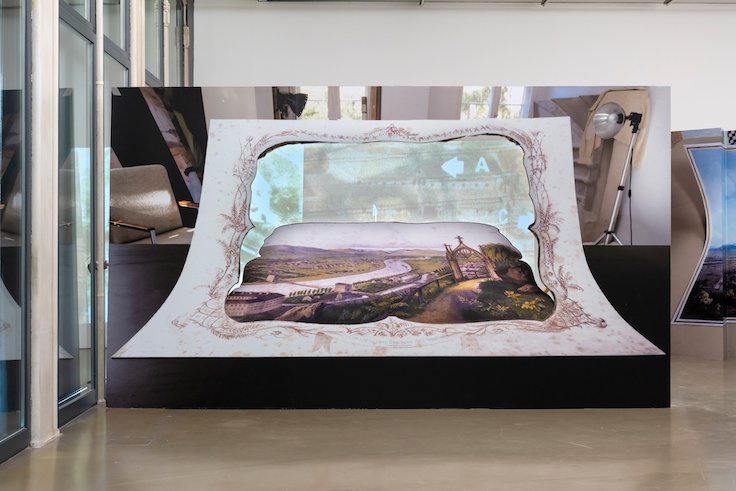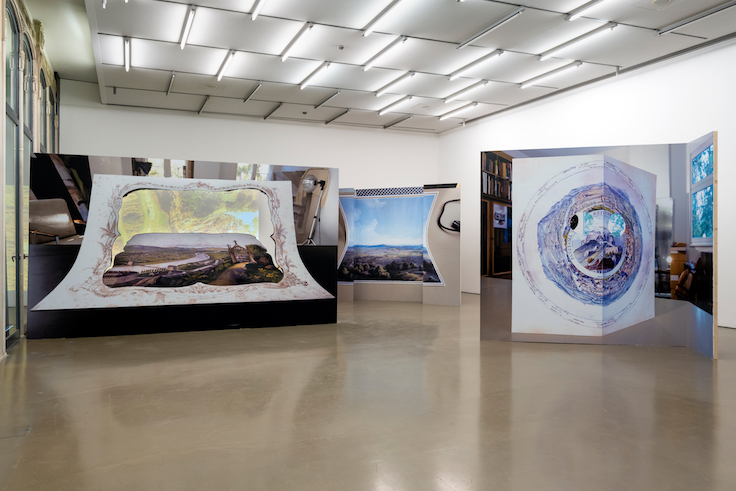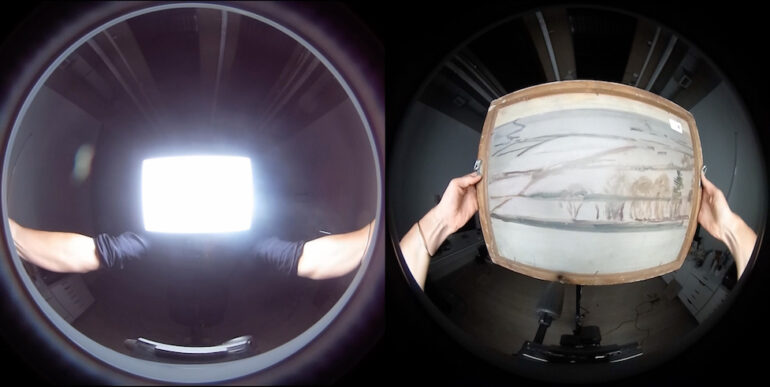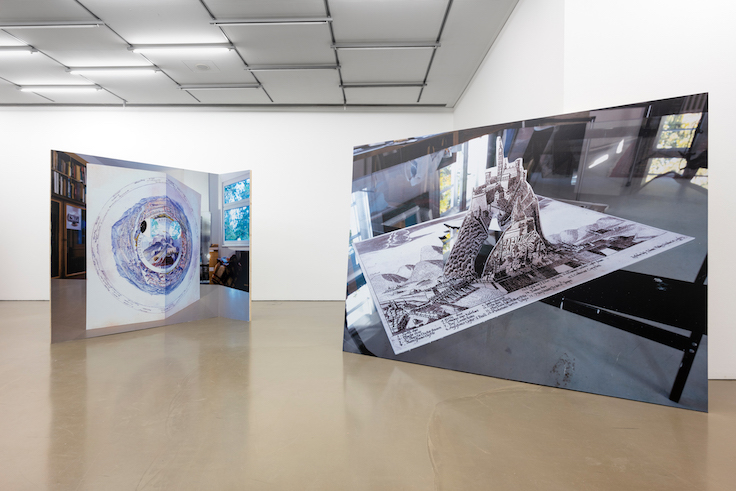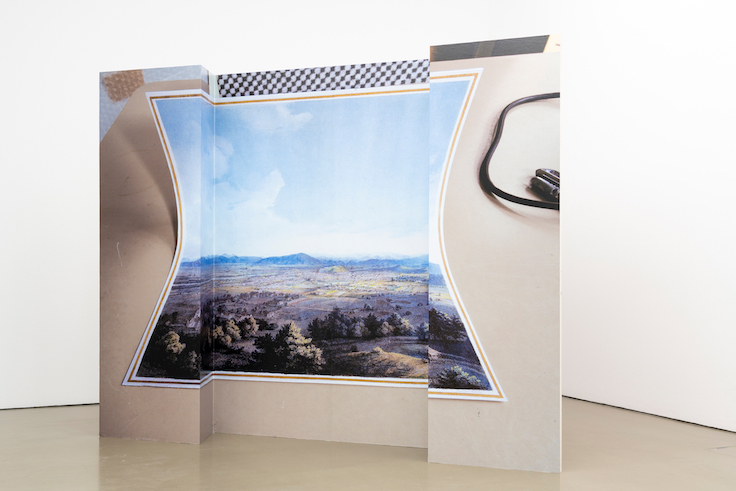Press information
Alexandra Leykauf
Prospect
Infos
Press preview
1.3.2024, 11 a.m.
Opening
1.3.2024, 6 p.m.
Duration
2.3. – 12.5.2024
Opening hours
Tue – Sun and bank holidays
10 a.m. – 6 p.m.
Curated by
Anna Voswinckel
Press downloads

Press Information
How do we see the world conveyed through images? What perception of space is engendered by the single-lens perspective of the camera? Alexandra Leykauf analyzes the gaze which, since the invention of photography, has been reproducible through technology in manifold ways. She creates pictorial spaces that initially seem to have little to do with photography. As exhibition visitors, we move through a parcourse of architectural elements that present reproductions of reproductions as individually fashioned displays. Here, the shift between different planes of reproduction gives rise again and again to trompe l’oeil effects between the two- and three-dimensional—allowing us to reflect on the relationship between the gaze (visual space), canvas/display, and image.
Playing a decisive role in photography, along with the selection of motif and the framing, is the perspective of the beholder. The way we perceive a photograph is indeed influenced by our own personal point of view. In exploring this, Alexandra Leykauf takes varied approaches to employing the motif of the landscape in her work. Here, landscape serves as an interface between the beholder and the image. How is the gaze directed and where do I position myself? Am I in front of the picture, in the picture, or behind the picture? What worldview is being conveyed through a landscape painting and how is this mirrored in my gaze? Alexandra Leykauf visits art collections and libraries to immerse herself in local contexts, and to study the history and topography of an exhibition locale.1 She prints out reproductions of the found images, or she films and photographs them—usually as tabletop shots—and affixes them to architectural elements in highly enlarged form. Pictorial spaces that we can enter thus arise—diaphanous displays.
For the exhibition Prospect at Camera Austria, Leykauf brings five newly developed picture panel objects together with her video works for the first time, enabling the formation of thematic clusters that are mediated transmedially. The artist’s studio comes up repeatedly as a form of self-localization. In contrast to Caspar David Friedrich’s Wanderer above the Sea of Fog (ca. 1817), Leykauf devises a Self in pictorial space that crystallizes through traces of everyday life, through architecture and furniture. In doing so, she does not use the image-generation methods available to us today primarily to create new pictures. Rather, she harnesses the means of photographic reproduction, of scanning and filming found images, with an aim to examine our relationship, our points of access, to these pictures.
The artist selected photographs from the collections of the Graz Museum, the Neue Galerie Graz, and the Styrian History Museum. Most of these works’ titles already mention vantage point and/or view: Joseph Kuwasseg’s lithographs Aussicht vom Grazer Schloßberg (Prospect from Graz’s Schloßberg, 1850) and Blick auf Graz von St. Peter (Panorama Graz) (View of Graz from St. Peter, ca. 1850); Friedrich Gauermann’s painting Blick gegen Muggendorf (View toward Muggendorf, ca. 1840); and the seventeenth-century engraving Grätz die Haubt Statt in Steyer (Graz, the Main City in Styria, n. d.) and the print Panorama von Graz, aufgenommen vom Schlossberg (Panorama of Graz, Taken from the Schlossberg, 1865), with the latter produced in editions. These pictures, with their different perspectives on landscape, all reflect an approach to the distribution of power typical of the time: the gaze from town looking up toward the mountain and the castle, as seen at the center of the touristy Panorama von Graz, differs from the open vista from the opposite spot, stretching out across the city and the surrounding landscape, as found in Kuwasseg’s Aussicht vom Grazer Schloßberg. Or is the exposed Schloßberg actually a vis-à-vis on the same footing with us, gazing down at us, as the anthropomorphic landscape of the early modern engraving Grätz die Haubt Statt in Steyer might suggest?
Lying on a glass table in Alexandra Leykauf’s studio is an oversized reproduction of a photograph she took of the latter engraving with its view of Graz from a high-angle perspective; we see a black-and-white print of the work, which the artist had clipped in order to make the mountain fold out like a pop-up card. This serves to further emphasize the aspect of movement, of the animated, analogizing the mountain motif with a figure brought to life.
In a series of framed portraits (2019–21) we encounter anthropomorphic elements. At first glance, they seem like naive paintings, yet upon closer examination they turn out to be reproductions of various landscape paintings drawn over in black. Leykauf coated pages from art catalogues with photo emulsion and covered in sand those parts of the reproduction where she believed to see a face; then she exposed the sheets in the darkroom. The landscape portraits are titled according to the first names and abbreviated surnames of the painters—this deliberate lack of distance challenges the authority of the respective artist, placing him on the same plane as the landscape through an inversion of subject and object. The landscape returns our gaze in the form of a portrait. This must also be seen as a critical examination of the occupation of space, which is imparted through these pictures made mainly by male landscape painters. Leykauf describes her preoccupation with these works against this background as movement between analysis and being in love—reflecting, in equal measure, a feminist critique and a deep appreciation of the artworks.
This series of framed portraits is juxtaposed with the oversized reproduction of the painting Blick gegen Muggendorf. As one of Austria’s first landscape painters, Friedrich Gauermann made visible the painterly development of space as a gradual coloristic appropriation of parcels of landscape. The processual nature of the painting technique is lent emphasis by omissions in the lower left half of the picture. Covering the image panel is a flat screen showing Leykauf’s Cliché Verre (2017). In this video work, we are gazing at a black-coated pane of glass, which from behind is liberated from its layer of paint by and by. This reveals two visual spaces at the same time: the finger drawing of a landscape and, simultaneously, a filmic self-portrait of the artist in her studio. Leykauf is behind the pictorial surface as a protagonist, meaning she is in the picture. She employs the stroke of her finger like a brushstroke, drawing first a horizon line and then progressively creating an (abstract) landscape through the removal of paint. With each wipe, more details of the studio background are ultimately allowed to shine through—signifying a localization of the painting, yet at the same time a materialization of the pictorial surface, underscored by the sound of wiping and scratching. The term cliché verre (glass print) denotes a method of photographic reproduction that was used primarily by landscape painters in the nineteenth century. A glass plate was darkened with soot, and then the soot was scratched off in places. After that, the glass plate was placed on photo paper and exposed. Leykauf is hence deliberately calling to mind an analogy to the negative-positive process in photography.
In terms of form, the more recent video works Schnecken (Slugs, 2021) and Spatzen (Sparrows, 2023) exhibit parallels to Cliché Verre. They show time-lapse footage of animals whose movements have been inspired by a search for food. In both cases, the camera is positioned like a scanner below the picture plane, thus pointing, on the one hand, to this high-tech imaging technique and, on the other, to foundational and rather archaic processes of image creation that are triggered by tracks, secretions, or weather, that is, by physical exposure. This aspect is also evident in Leykauf’s video work Geographics of the Table (2019), where, on a fixed picture plane resulting from a high-angle view on a glass table, ever-changing prosaic still lifes are created using stop-motion filming.
In the main exhibition space, at the end of the row of windows, we find ourselves standing in front of a large image panel with an opening, through which we can see a video projection. The image on the panel is a photographic reproduction of the lithograph Aussicht vom Grazer Schloßberg by Joseph Kuwasseg. Released in the mid-nineteenth century in an eight-part portfolio, the work presents an open view from the vantage point of the Schloßberg, staging a panoramic vista distinguished by high topographical accuracy. The cast-iron elements of the ornate gate signalize that modernity has arrived; suggested here is also a connection to Graz’s Eisernes Haus, likewise erected in the mid-nineteenth century and since 2003 home to Camera Austria. In this photograph by Leykauf, details from her studio are discernible beyond the edge of the reproduced lithograph. The artist renders these details as a second decorative frame, so to speak, thus inverting interior and exterior space—and thus also the plane of representation. While typical portraits from the Biedermeier period show Graz’s middle class in splendid interiors with a view of the Schloßberg from their windows, Leykauf reverses the direction of the gaze to instead focus on the sublime, unfettered view from the mountain, which is brought into one’s own four walls, yet becomes diaphanous at the very same time.
Thanks to the gap in the panel, the video piece aerial (2018) can be seen even from afar—an exploration of the purported objectivity of satellite imagery and that of vertical visual dispositifs that enable landscapes to flow through the frames of our screens and the Earth’s surface to be zoomed in and out. Based on aerial footage of fields and meadows found by chance in books that are collected in a regional archive in England, the artist noticed perceptible changes in vegetation or “crop marks” in the reproductions of these photographs—a sign of walls or trenches concealed underground that influence the growth of plants. Such structures, which are only visible from the air, are tangible remnants of earlier cultures. Leykauf scanned the respective pages with a pocket scanner against the light of a windowpane, allowing illustrations and texts on the flip side to shine through. Later, she combined the scans to create an imaginary landscape, which she animated through a blend of virtual flight and digital map navigation. To this the artist added audio field recordings that she had made at some of the sites seen in the photographs. Through this simple technique based on analogue material, the video clearly illustrates how (cultural) history is not primarily conveyed through a linear reproduction of coordinates, but rather only truly becomes graspable by transferring, compiling, and superimposing layers of knowledge.
To the right of aerial is the enlarged reproduction of the second motif by Joseph Kuwasseg, Blick auf Graz von St. Peter (Panorama Graz), presented on a folding-screen-like image panel. Like the other mounted visual motifs, this is a photo of the lithograph reproduction, placed on the surface of a table. At the level of the horizon line, the sheet is curved upward, accentuating the vanishing line and the way the gaze is drawn into the landscape. Created at the same time is a seamless background, familiar to us from photo studios. On the table we also see an electrical cord and a black-and-white grid of pixels, similar to the background layer of the image-processing software Photoshop.
The lithograph of the Graz basin toys with an intense color perspective and with contrasts of light and dark to create a totality of landscape into which the eye is drawn. This movement is emphasized through the concave form of the display, behind which two older video works are positioned: Thuner See (Lake Thun, 2017) and Sunset Harbor at Rio (2016). Similar to aerial, in both videos the reproductions of landscapes are the point of departure for an examination of the materiality and physicality of the print medium, on the one hand, and for both films touching on the key issue of landscape art: an orientation to the horizon line. No matter how strongly an image is deconstructed or distorted—as long as a central horizontal line is perceptible, then the illusion of the infinity of pictorial space remains intact for our gaze so well trained to embrace linear perspective.
This relates to the picture panel featuring the photo of the reproduction of the print Panorama von Graz, which is based on a drawing by Carl Reichert; it was likewise situated on a table when the photograph was shot. The reproduction of the print is folded vertically in the middle and given two round holes, which look a bit like eye sockets and give the rendering the aura of a creature. Visible in the background are details from Leykauf’s studio—a window, a library, a mirror, and a folded-up rug. In the reproduced print, the Schloßberg is essentially at the center of a tourist cosmos. Topographical details and attractions are listed in a ring around the city of Graz, which is depicted as a globe. The drawing symbolizes how space is made available through the disembodied panoramic view. Leykauf references the contradiction of embodied seeing first through the two peepholes she cut into the reproduction and second through a juxtaposition with her video work recto/verso 360° (2017). Here, the artist uses a 360-degree camera to capture landscape paintings from an art collection in southern England both recto and verso; these are canvases with paintings on both sides. In the situation of shooting the picture, the artist assumes the position of pictorial carrier (in two senses of the word), positioning herself between the camera and the image, like a display. This gives rise to a dual beholder situation, one familiar to us from surveillance cameras. The adjacency of the two camera sight lines, each of which encompasses half of a sphere, appears to facilitate an all-encompassing view. Yet, as beholders, we find it difficult to read the images, since we cannot comprehend the decoupled gaze of the two camera images. In her recto/verso 360°, Leykauf takes the idea of visualized three-dimensionality based on images such as those transmitted by 360-degree or virtual reality cameras to the point of absurdity. Each and every camera shot must be displayed on a carrier and is thus inevitably two-dimensional, regardless of the form this display takes. One-eyed by nature, cameras cannot deliver three-dimensional images. Displays make it possible for us to view pictures analytically, with three-dimensionality being generated in our minds and bodies. The work of Alexandra Leykauf makes this clear as well.
Alexandra Leykauf (b. in 1976) studied at the Academy of Fine Arts Nuremberg (DE) and at the Gerrit Rietveld Academie in Amsterdam (NL). She lives and works in Berlin (DE).
Images
Publication is permitted exclusively in the context of announcements and reviews related to the exhibition and publication. Please avoid any cropping of the images. Credits to be downloaded from the corresponding link.


